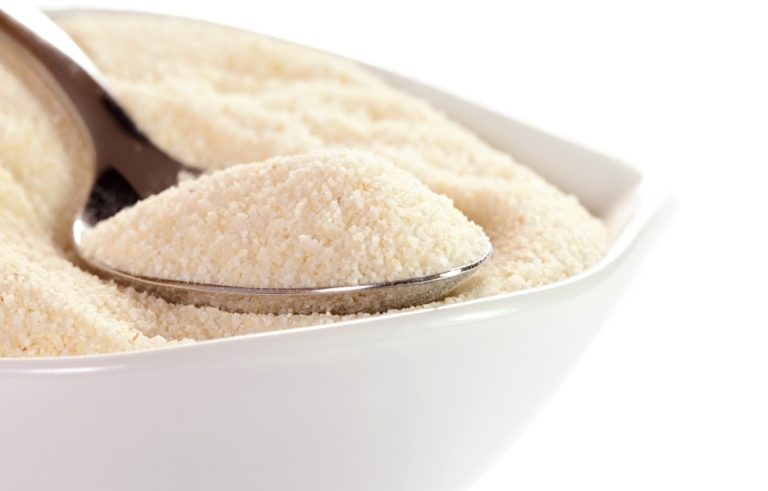ما الفرق بين سميد الفرخه والسميد العادي؟
ما هي استعمالات طحين الفرخة؟
ما هي مكونات طحين الفرخة؟
ما هو الفرخة؟
ما هو طحين الفرخة؟
يعتبر طحين الفرخة من المصطلحات التي يمكن أن تثير الفضول لدى العديد من الأشخاص، خاصة إذا لم يكونوا على دراية بمفهومه. قد يبدو الأمر غامضًا أو مدهشًا للبعض، ولكنه في الواقع يمثل مكونًا أساسيًا في صناعة الأعلاف والتغذية للطيور والدواجن. سنقوم في هذه المقالة بالتعرف على طحين الفرخة، وسنتناول مكوناته واستخداماته الشائعة.
طحين الفرخة هو عبارة عن منتج تم تصنيعه من فروج الفراخ المذبوحة، والذي يشمل عادة الجزء اللحمي الناتج عن هذه العملية. يتم سحق هذا اللحم وتجفيفه جيدًا حتى يتحول إلى مسحوق ناعم. يمكن أن يكون هناك تنوع في تركيبة طحين الفرخة، حيث يمكن إضافة مكونات أخرى مثل العظام والأمشاج الغذائية الأخرى.
يعتبر طحين الفرخة مصدرًا غنيًا بالبروتين، والذي يعد أمرًا أساسيًا لنمو وتطوير الفراخ والطيور بشكل عام. يحتوي على نسبة عالية من البروتين، والأحماض الأمينية الأساسية، والفيتامينات والمعادن الضرورية لتحقيق نمو صحي وقوة لدى هذه الكائنات. بالإضافة إلى ذلك، يعزز طحين الفرخة الصحة العامة للدواجن والطيور، ويساهم في تعزيز إنتاج البيض لديها.
استخدامات طحين الفرخة متنوعة، وتشمل:
- الأعلاف الحيوانية: يتم إضافة طحين الفرخة إلى الأعلاف المستخدمة في تغذية الدواجن والطيور، حيث يساهم في تعزيز نموها وزيادة إنتاج اللحم والبيض.
- الأعلاف السمكية: يمكن أيضًا استخدام طحين الفرخة في صناعة الأعلاف المخصصة للأسماك، حيث يعتبر مصدرًا غنيًا بالبروتين والعناصر الغذائية.
- التصنيع الغذائي: قد يتم استخدام طحين الفرخة في بعض المنتجات الغذائية المصنعة كمكمل غذائي بغرض زيادة القيمة الغذائية.
- الأسمدة: يمكن استخدام طحين الفرخة في صناعة الأسمدة الزراعية لزيادة محتوى النيتروجين في التربة.
يجدر بالذكر أن هناك اهتمامًا متزايدًا بالمسائل البيئية والاستدامة، وهذا يطرح تحديات على صناعة تجارة طحين الفرخة. يجب مراعاة مسائل الاستدامة والصحة العامة في صناعة هذا المنتج.
What is Chicken Meal?
Chicken meal is a term that might pique the curiosity of many people, especially if they are not familiar with its concept. It may appear mysterious or intriguing to some, but in reality, it represents a fundamental component in the poultry and animal feed industry. In this article, we will explore what chicken meal is, its components, and its common uses.
Chicken meal is a product manufactured from slaughtered broiler chickens, typically comprising the meaty parts resulting from this process. This meat is crushed and thoroughly dried until it transforms into a fine powder. The composition of chicken meal may vary, as it can include other components such as bones and additional nutritional supplements.
Chicken meal is a rich source of protein, which is essential for the healthy growth and development of chicks and poultry in general. It contains a high percentage of protein, essential amino acids, vitamins, and minerals necessary to achieve healthy growth and strength in these animals. Furthermore, chicken meal promotes the overall health of poultry and birds and contributes to increasing their meat and egg production.
The uses of chicken meal are diverse and include:
- Animal Feeds: Chicken meal is added to animal feeds used in poultry and bird nutrition, enhancing their growth and increasing meat and egg production.
- Fish Feeds: Chicken meal can also be used in the production of feeds for fish, serving as a rich source of protein and essential nutrients.
- Food Manufacturing: Chicken meal may be used in some processed food products as a nutritional supplement to boost their nutritional value.
- Fertilizers: Chicken meal can be used in the manufacturing of agricultural fertilizers to increase the nitrogen content in the soil.
It is worth noting that there is a growing focus on environmental and sustainability issues, which poses challenges to the chicken meal industry. Sustainability and public health concerns must be considered in the production of this product.
In conclusion, chicken meal is a product that plays a vital role in poultry and animal nutrition, serving as a key component in the feed industry. It provides the necessary protein and nutrients for the healthy growth of these animals, helping to meet global food security needs. With increasing interest in sustainability and public health, ongoing research and developments in this field are crucial to ensure the sustainable and healthy use of chicken meal.
Chicken meal, also known as poultry meal, is specifically processed to be used in animal and poultry feeds. This highly concentrated source of nutrients offers several advantages in the animal feed industry. It is often used as a key ingredient due to its balanced composition of essential amino acids, minerals, and vitamins. Chicken meal is produced from chicken by-products, including skin, feathers, and even some bones, making it a cost-effective way to utilize the entire bird without wastage. Its consistent quality and nutritional value have made it a staple ingredient in animal diets, ensuring optimal growth and health for a variety of livestock and poultry species.
Soft Chicken Meal
In addition to traditional chicken meal, there is another product known as “soft chicken meal,” which has gained popularity in recent years. Soft chicken meal is produced through a slightly different process, which involves lower-temperature cooking and finer grinding. This results in a finer and more digestible texture, making it a suitable choice for feeding young animals or animals with special dietary requirements. Soft chicken meal offers the same nutritional benefits as regular chicken meal but with improved digestibility, making it an ideal choice for pet food, especially for puppies, kittens, and other animals with sensitive digestive systems. Its versatility and ease of digestion have made it a valuable addition to the pet food industry.
What is Semolina?
Semolina is a versatile ingredient commonly used in cooking and baking around the world. It is a coarse, purified wheat middlings, and it can be made from durum wheat or softer wheat varieties. Semolina is known for its distinctive pale yellow color and gritty texture. This ingredient is often used in various culinary applications, such as making pasta, bread, puddings, and desserts. Due to its high gluten content, it is particularly well-suited for pasta production, where it helps create the desired chewy texture. Semolina’s unique properties and versatility make it a staple in many kitchens, and it adds a pleasant texture and flavor to a wide range of dishes.
Semolina in Culinary Uses
Semolina’s versatility extends to a wide array of culinary applications. It serves as a fundamental ingredient in various types of pasta, including traditional Italian pasta like spaghetti, fettuccine, and gnocchi. The high gluten content in semolina aids in pasta dough’s elasticity and gives it the ideal texture when cooked.
Besides pasta, semolina is used in making various types of bread and baked goods. It adds a pleasant texture and crumb structure to bread, resulting in a crusty and airy interior. Semolina bread is particularly popular in some regions for its distinct flavor and texture.
Semolina is also a key component in dessert-making. It is used to make traditional desserts like halva, a sweet confection made by cooking semolina with sugar, ghee, and nuts. Additionally, semolina is often used to prepare porridge and puddings in many cultures.
In some cuisines, semolina is incorporated into savory dishes like couscous, which is a staple food in North African and Middle Eastern cuisines. Semolina’s unique texture and ability to absorb flavors make it a versatile ingredient for both sweet and savory dishes, contributing to a rich and diverse culinary heritage around the world.
Zero Flour: A Gluten-Free Alternative
For individuals with gluten sensitivity or celiac disease, regular wheat-based flours like semolina can be problematic. This has led to the development of alternative flours, such as “zero flour” or gluten-free flours. Zero flour is a gluten-free substitute used in various recipes to accommodate dietary restrictions. It is typically made from non-wheat sources like rice, corn, or a combination of different grains. Zero flour allows people with gluten intolerance to enjoy dishes like pasta, bread, and desserts without the adverse effects of gluten. While it may have a slightly different texture and flavor compared to traditional wheat-based flours, zero flour has become an essential ingredient for those seeking gluten-free options, making it a popular choice in the ever-expanding world of alternative flours.
سؤال: ما الفرق بين سميد الفرخة والسميد العادي؟
جواب: الفرق الرئيسي بين سميد الفرخة والسميد العادي يتمثل في المصدر والاستخدام. سميد الفرخة هو منتج مشتق من فراخ الدواجن ويتم استخدامه عادة في صناعة الأعلاف الحيوانية، حيث يعتبر مصدرًا غنيًا بالبروتين والمواد الغذائية الأساسية لتغذية الدواجن والطيور. بالمقابل، السميد العادي هو منتج مصنوع من القمح ويستخدم في مجموعة متنوعة من الأطعمة مثل العصائر والمخبوزات والحلويات. لذلك، الفرق الرئيسي هو في مصدر المكون والاستخدام المقصود لكل منهما.
سؤال: ما هي استعمالات طحين الفرخة؟
جواب: طحين الفرخة له العديد من الاستعمالات الهامة، وتشمل:
- الأعلاف الحيوانية: يتم إضافة طحين الفرخة إلى الأعلاف المستخدمة في تغذية الدواجن والطيور، حيث يساهم في تعزيز نموها وزيادة إنتاج اللحم والبيض.
- الأعلاف السمكية: يمكن أيضًا استخدام طحين الفرخة في صناعة الأعلاف المخصصة للأسماك، حيث يعتبر مصدرًا غنيًا بالبروتين والعناصر الغذائية.
- التصنيع الغذائي: قد يتم استخدام طحين الفرخة في بعض المنتجات الغذائية المصنعة كمكمل غذائي بغرض زيادة القيمة الغذائية.
- الأسمدة: يمكن استخدام طحين الفرخة في صناعة الأسمدة الزراعية لزيادة محتوى النيتروجين في التربة.
بالإضافة إلى هذه الاستعمالات الشائعة، هناك اهتمام متزايد بمسائل الاستدامة والبيئة في صناعة طحين الفرخة، وهذا يطرح تحديات جديدة تتطلب البحث والتطوير المستمر.
سؤال: ما هي مكونات طحين الفرخة؟
جواب: مكونات طحين الفرخة تشمل عادة الجزء اللحمي المستخدم في إعداد اللحم المذبوح من فراخ الدواجن. يتم سحق هذا اللحم وتجفيفه جيدًا حتى يصبح مسحوقًا ناعمًا. يمكن أيضًا إضافة مكونات أخرى مثل العظام والأمشاج الغذائية الأخرى حسب الحاجة واستخدام الطحين. تكون نسبة المكونات والتركيبة الدقيقة لطحين الفرخة قد تختلف من منتج لآخر وفقًا لاحتياجات المستهلكين والمتطلبات الصناعية.
سؤال: ما هو الفرخة؟
جواب: الفرخة هي الاسم الذي يطلق عادة على الصغار من الدواجن، وخاصة على الصغار من الدجاج. تشير الكلمة عمومًا إلى الفراخ التي لم تكبر بعد والتي تمثل مرحلة مبكرة من حياة الطيور. الفراخ تكون عادة هشة وصغيرة، وتحتاج إلى رعاية وتغذية خاصة لضمان نموها وتطورها بشكل صحي. تربى الفراخ عادة لأغراض مختلفة مثل إنتاج اللحم أو البيض، وهي جزء مهم في صناعة الدواجن وتلبية الاحتياجات الغذائية للبشر.
في الختام، يمكن القول إن طحين الفرخة هو منتج يلعب دورًا هامًا في تغذية الطيور والدواجن، وهو مكون أساسي في صناعة الأعلاف. يوفر البروتين والمغذيات الضرورية لنمو وتطوير هذه الكائنات بشكل صحي، ويساهم في تلبية احتياجات الأمن الغذائي في العالم. ومع تزايد الاهتمام بالاستدامة والصحة العامة، يجب متابعة البحث والتطورات في هذا المجال لضمان استخدام طحين الفرخة بشكل مستدام وصحي.





